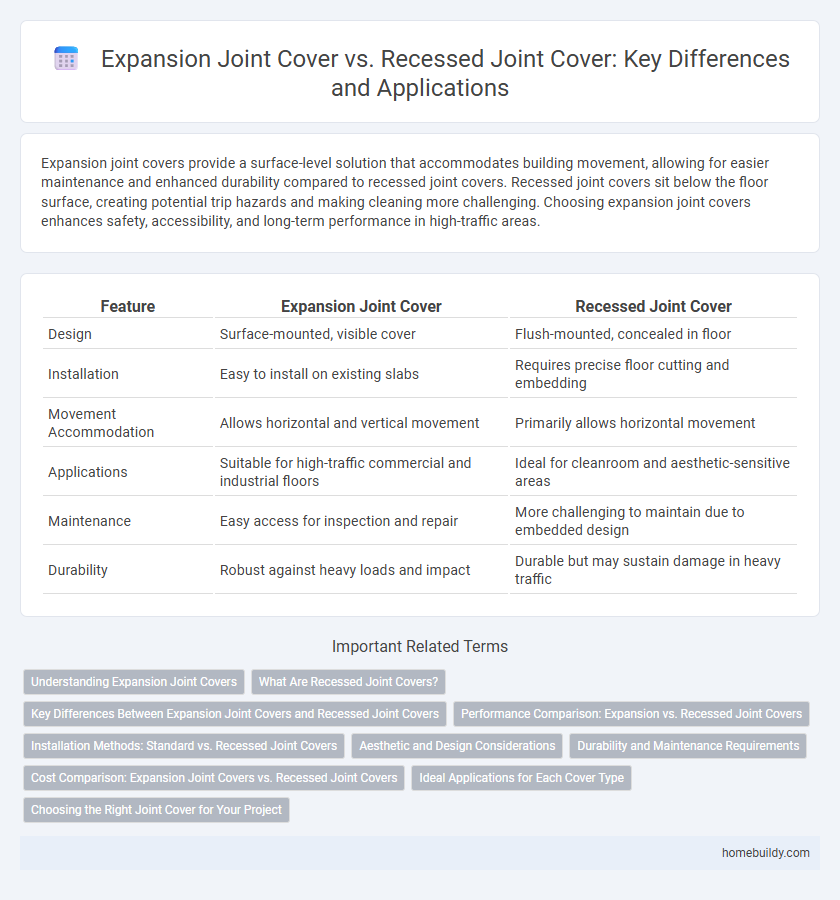Expansion joint covers provide a surface-level solution that accommodates building movement, allowing for easier maintenance and enhanced durability compared to recessed joint covers. Recessed joint covers sit below the floor surface, creating potential trip hazards and making cleaning more challenging. Choosing expansion joint covers enhances safety, accessibility, and long-term performance in high-traffic areas.
Table of Comparison
| Feature | Expansion Joint Cover | Recessed Joint Cover |
|---|---|---|
| Design | Surface-mounted, visible cover | Flush-mounted, concealed in floor |
| Installation | Easy to install on existing slabs | Requires precise floor cutting and embedding |
| Movement Accommodation | Allows horizontal and vertical movement | Primarily allows horizontal movement |
| Applications | Suitable for high-traffic commercial and industrial floors | Ideal for cleanroom and aesthetic-sensitive areas |
| Maintenance | Easy access for inspection and repair | More challenging to maintain due to embedded design |
| Durability | Robust against heavy loads and impact | Durable but may sustain damage in heavy traffic |
Understanding Expansion Joint Covers
Expansion joint covers are designed to bridge gaps between building sections, allowing for movement caused by thermal expansion, seismic activity, or structural shifts, while recessed joint covers are embedded within the floor or wall surface to provide a flush finish. Expansion joint covers typically accommodate larger movements and are visible, offering better protection against debris and water infiltration. Understanding the differences in design, functionality, and application is essential for selecting the appropriate system to ensure structural integrity and aesthetic continuity.
What Are Recessed Joint Covers?
Recessed joint covers are designed to sit flush within the floor surface, providing a discreet and seamless appearance while accommodating building movement. These covers are typically installed by embedding into the floor structure, which protects the expansion joint from surface-level wear and allows for a smooth transition over the joint. In contrast to surface-applied expansion joint covers, recessed joint covers offer enhanced aesthetic integration and reduced trip hazards in high-traffic areas.
Key Differences Between Expansion Joint Covers and Recessed Joint Covers
Expansion joint covers are designed to bridge gaps while accommodating structural movement, offering visible surface integration and protection against debris infiltration. Recessed joint covers sit flush within the floor or wall surface, providing a cleaner aesthetic but often with limited flexibility for movement compared to expansion joint covers. The primary difference lies in their installation depth and capacity for movement accommodation, impacting both functionality and design application.
Performance Comparison: Expansion vs. Recessed Joint Covers
Expansion joint covers provide superior flexibility and load-bearing capacity compared to recessed joint covers, making them ideal for accommodating significant structural movements in commercial and industrial buildings. Recessed joint covers, while visually discreet, are generally less effective in managing large thermal expansion and seismic activities due to their limited movement accommodation. Choosing between expansion and recessed joint covers requires assessing the building's dynamic load conditions and desired aesthetic outcomes to ensure optimal performance and durability.
Installation Methods: Standard vs. Recessed Joint Covers
Expansion joint covers are installed using surface-mounted methods that allow for easier access and maintenance, while recessed joint covers require precise cutting and embedding into the substrate for a flush finish. Standard expansion joint covers typically utilize mechanical anchors or adhesives for swift application, whereas recessed covers demand additional preparation such as concrete grinding or framing to ensure secure fitting. The choice between these installation methods impacts both the project timeline and the aesthetic integration within architectural designs.
Aesthetic and Design Considerations
Expansion joint covers offer a seamless surface integration that enhances aesthetic appeal by maintaining a continuous visual flow, whereas recessed joint covers create visible indentations that may disrupt design uniformity. The flush installation of expansion joint covers supports modern architectural styles seeking minimalistic and clean lines. Designers often prefer expansion joint covers for spaces prioritizing both durability and unobtrusive visual impact.
Durability and Maintenance Requirements
Expansion joint covers typically offer superior durability compared to recessed joint covers due to their robust materials designed to withstand heavy traffic and environmental stress. Maintenance requirements for expansion joint covers are generally lower, as their surface-level installation simplifies cleaning and inspection processes. In contrast, recessed joint covers often require more frequent upkeep to prevent debris accumulation and potential damage within the joint cavity.
Cost Comparison: Expansion Joint Covers vs. Recessed Joint Covers
Expansion joint covers typically incur higher initial costs due to more complex materials and installation requirements compared to recessed joint covers, which are generally more budget-friendly and easier to install. Maintenance expenses for expansion joint covers can be greater because of their exposure and moving parts, whereas recessed joint covers benefit from protection within the slab, reducing wear and maintenance needs. Evaluating project budgets and long-term maintenance plans is essential when deciding between expansion joint covers and recessed joint covers for optimal cost efficiency.
Ideal Applications for Each Cover Type
Expansion joint covers are ideal for high-traffic areas requiring surface continuity and surface protection, such as commercial walkways and parking structures, offering flexibility and durability. Recessed joint covers suit environments prioritizing aesthetic integration and minimal surface obstruction, like interior floors and architectural spaces, blending seamlessly with the flooring. Choosing the right cover depends on balancing functional requirements like load capacity and visual impact specific to the expansion joint's location.
Choosing the Right Joint Cover for Your Project
Expansion joint covers provide surface-level protection and accommodate structural movement, making them ideal for areas requiring easy accessibility and maintenance. Recessed joint covers sit flush with the floor, offering a seamless appearance and reducing trip hazards, which suits high-traffic environments and aesthetic-focused projects. Selecting between expansion joint covers and recessed joint covers depends on factors such as load capacity, movement range, and architectural design requirements.
expansion joint cover vs recessed joint cover Infographic

 homebuildy.com
homebuildy.com